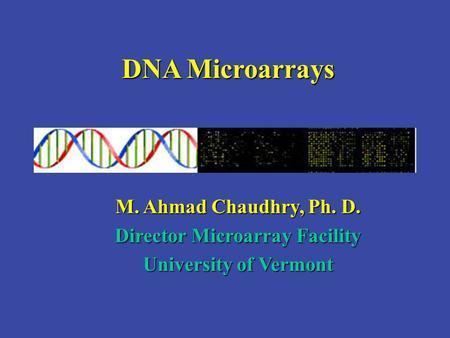Name M. Chaudhry | ||
 | ||
Education | ||
M. Ahmad Chaudhry is an American radiologist, Associate Professor at the University of Vermont, and Interim Associate Dean for Research, in the College of Nursing and Health Sciences.
Contents
- Education
- Research Interests
- The role of micro RNA in the cellular response to radiation treatment
- Selected publications
- References
He received a Ph.D. degree in molecular biology from the University of Manchester, UK. He did postdoctoral research work at University of Alberta, Canada, before joining University of Pennsylvania as a Senior Research Investigator. His research interests are micro-RNA responses to radiation exposure, radiation-induced bystander effect, cell cycle perturbations and the enzymatic processing of clustered DNA damage.
Education
Research Interests
The role of micro-RNA in the cellular response to radiation treatment
Ionizing radiation interferes with cellular functions at all levels of cell organization. The ionizing radiation-induced stress response is very complex and involves many cellular processes. Dr. Chaudry is investigating the involvement of small non-coding micro-RNA in the response of human cells exposed to ionizing radiation. Micro RNAs (miRNAs) are small non-protein-coding single-stranded RNAs of ~22 nucleotides that function as negative gene regulators. miRNA negatively regulate their targets either by binding with perfect or nearly perfect complementarity to protein coding mRNA sequences to induce the RNA-mediated interference (RNAi) pathway. Most miRNAs do not cleave their mRNA targets as a mechanism of gene regulation. These miRNAs bind to imperfect complementary sites within the 3′ untranslated regions (UTRs) of their mRNA targets. In this case the target-gene repression occurs post-transcriptionally at the level of translation resulting in reduced protein levels but the mRNA levels remain unaffected. A single miRNA has the capability to bind to as many as 200 diverse gene targets ranging from transcription factors, secreted factors, receptors and transporters, thus potentially controlling the expression of about one-third of human mRNAs. Research has identified cell type specific modulation of several miRNA in gamma radiation and X-ray-treated human cells. Other studies from our laboratory showed that the expression of many miRNA markedly differ within the same cell line after exposure to either low or high doses of radiation. His work also identified radiation-induced modulation of miRNA in cells with altered DNA repair capability. These studies have provided evidence that miRNA are involved in the response to ionizing radiation exposure in human cells.
